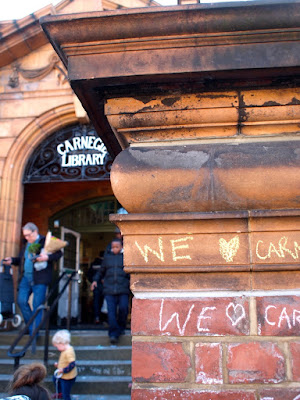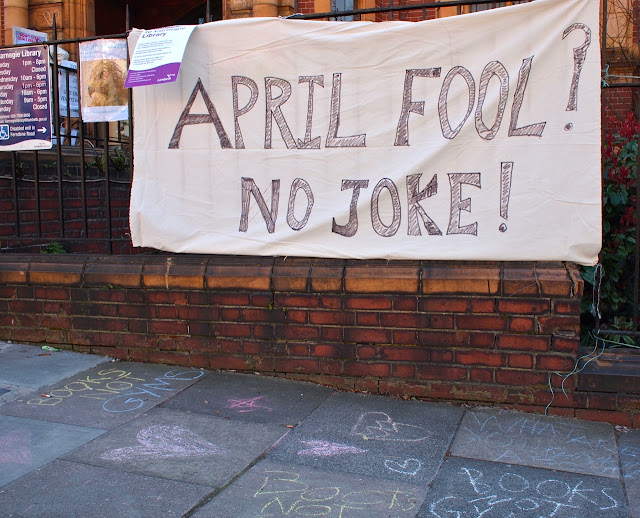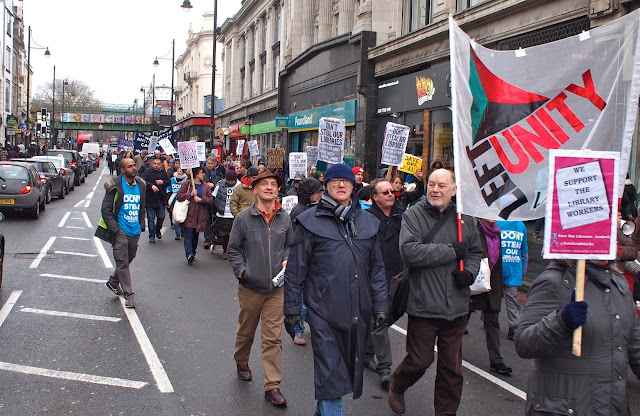
Two literary events in the space of five days: what's going on? Next stop Hay-on-Wye?
Well, probably not. But what, on these dead, cold March evenings could be better than a dash to a local shop or a pub, and get a free evening's entertainment from a bunch of talented and fascinating writers?
Well, for a cheapskate old blagger like me, the answer is: not very much. Which is why on Monday evening people queuing for buses around Clapham Common and Acre Lane glimpsed a mad old scarecrow, woolly-hatted, two scarves, two pairs of everything - cycling madly towards Tulse Hill.
Going as fast as possible, against the biting wind, just trying to keep warm. And thus arriving unfashionably early at the
Hootananny, Brixton, for the
13th quarterly Brixton Book Jam.
I remember writing these events up during a very short stint on doing listings for the Brixton Blog, and yet I never actually went to one - until this week. And realised immediately what a very fine thing it was that I'd been missing.
The Hootananny is one of those huge old roadhouse pubs that London used to have loads of. Now, they've fallen out of favour, and who knows how long it will be before we're signing petitions to save this one, à la Half Moon in Herne Hill?
No, perish that thought. This place is crazy but it's usually busy, there's music or comedy or something on every night, there are pool tables, food outdoors in the summer, and it has a little hotel too. The spaces are gloriously old school. For Monday's event, which had tipped its hat to late local boy David Bowie, there were rows of school-hall style chairs arranged across the dance floor.
Some of the anecdotes were memorable, notably those from the legendary photographer of the Manchester music scene (and Man City),
Kevin Cummins.

Instead of plugging any of his books in particular, Kevin ad-libbed a bit about his times shooting David Bowie. The first time when he was still a student and devoted Bowie fan and thus too much in awe of the man to get the shot he wanted (He did get the shot a day or two later on the next stage of the tour, in Leeds).
He told the best story about Bowie I've heard since the man died. It involved Bjork. He also showed a pic taken at an early Smiths gig in Manchester, with two punkish girl fans, and then announced that both these girls were in tonight's audience. "See if you can spot them!" Cringe. But everyone could spot them (especially as he waved the mike at their table).
The second memorable Bowie anecdote came from local artist Nathalie Dubruel, who had been an extra in a shoot for one of Bowie's videos. It was in the early 1980s and the location was the famous Wag Club in Soho (a place I already knew I was too old and dull to get into in 1984 even though I was desperate to be there, having read all about it in The Face).
She told the story with all the enthusiasm of her teenage self, down to the bit where she sees the video for the first time, and see herself dancing directly in from of the (frankly, overdressed) star-man "wearing my Woolworths t-shirt".
It was again instant transportation back to those strange days, when they started making videos for MTV even though we couldn't get it here at the time.
There were also some good poetic imaginings about, or inspired by, Bowie. Bowie on a cold night in desert in Sudan, watching the tracer shells from some rebel encampment. It was mind-blowing stuff. I think that was Richard Skinner - but there was so much good stuff. That's the thing about a jam. It's a confiture…an embarrassment, almost, of riches, richness.
Another great memory from the Jam will be seeing Marcia Robinson talking about her dad:
Sledge - The Soul of Notting Hill.
She'd written this beautifully-illustrated memoir of her father, Gladstone "Sledge" Robinson, partly to keep his name alive, and because she'd promised him she would. Sledge died back in 2008, tragically, in a house fire which also destroyed most of belongings. By then he was know well beyond his London W11 manor as London's first Rasta Man, one who put up with no end of aggravation from police and others through the 60s and 70s and 80s for the dreadlocks he grew a full decade before anyone here had heard of Bob Marley.
Sledge was one the elders of London's West Indian community, famed for his dreadlocks, and his bongo drumming on Aswad and Bob Marley tracks. What was less well known outside the Notting Hill black community was his generosity, his strength as a community leader, and his role as a human rights activist.
He inspired people to stand up for their rights, Marcia said, and she conveyed very clearly that he was a great man who left an important legacy. And which other pioneer fighter for the UK's law centres and legal aid movement has also been - in his later years - a fashion model and cover star for GQ magazine?
You could tell, he had taught his daughter well, Marcia was a kind but powerful presence in the room, with a great voice and a great laugh.
One of the writers who attracted me to this event was
Martin Millar, who I always thought of as Brixton's own punk novelist, with an early novel, Lux the Poet, set at the time of the 1981 Brixton riots and squatting punks.
But of course Martin Millar is Scottish, and it may not be fanciful nonsense to imagine a bit of a link between his early writing and that of a slightly older Glaswegian surrealist writer Alasdair Gray.
These days he's a successful writer of fantasy fiction, but there's an echo of Lux in his latest novel,
Goddess of Buttercups and Daisies , which is his first historical novel. Alas, I was called away as he started to read, but the bit I picked up made me think he was in a way going back to the good old bad old surreal punk fiction of the 80s….so, he's another one to go check out again.
Debut novelist C D Ross completely changed the mood in the room with a reading from her book, Gangland, as a young mother encounters a gang fight on bonfire night in Clapton, and ends up comforting a stabbed teenager who is probably dying. Powerful, chilling stuff.
So, how do you top all that at a literary event?
Well, you don't need to, there's no topping anyone in this world. Well actually there is, as the final author made very clear. This was the poet Stefan Clark who has just written his first novel, which is "a prequel to Shakespeare's Hamlet set in modern times" called
Love and Blood and the State of Grace.
It was another firework display, a pyrotechnic reading; he put so much energy and malice into the character of the murderous Claud as he sets about humiliating and killing his brother (Harry) that at times you felt like taking cover. Great stuff in the mode of a Brendan Behan, but on who'd swallowed plenty of Bukowski , a spot of Henry Miller even, with just a hint of an Alexi Sayle style sense of black humour.
So, that was what a book jam is like. If I'd been sceptical, I am now a complete convert. It was jam of the choicest variety, a veritable confiture, Tesco's finest. On bread. With butter.
Oh, and by the way, this being the Brixton Book Jam, in Lambeth, meant that it also gave time and space to a librarian called Stevie ("luckily for me I work in Southwark") who explained what is happening to the 10 libraries in the borough, and encouraged everyone to sign the
Don't Steal Our Libraries petition and come along to
Thursday evening's meeting at Brixton Library. She received such a warm round of applause and cheering that you imagine most of the audience had already signed - but those who hadn't, will have now.
Thank god!
(PS: next Brixton Book Jam is on June 6)
And so, wind back the clock to last Thursday…
… and a five minute walk to the bijou Clapham Books to listen to author Leila Segal reading from Breathe, her collection of nine short stories about Cuba.
She had lived there for several years, first in Havana, then out west in what sounds like the idyllic province of Pinar del Rio.
Leila read fragments from the stories in a quiet but powerfully expressive way. You immediately got the flavour: it was careful, a tentative approach through which you got these glimpses of a vividly different world. She really brought the words to life. The small audience - ten people at most, sipping at their free glasses of red wine in the children's books room, were rapt. We nearly all had questions for her. She answered every one, fully. She clearly loves Cuba and loves talking about it, her enthusiasm was infectious and her knowledge deep.
There's a story of a British girl experiencing the sheer sensual pleasure of being at night-club, dancing with Cubans to West Coast rap music.
Another is seen from the pod of an Italian business man.
She's got a good, tough writing style, she doesn't waste words, but she does conjure up places and people with the flick of literary wrist…a perfect phrase here, a couple of words of dialogue there.
She made me want to go back to Cuba, though from all as he said things are actually a bit harder there now than when we went. All that expectation of the coming "thaw" in US-Cuban relations, it seems, is bringing out a different side, and maybe some of the old insects are going to be scuttling out from underneath the cupboard they've been hiding under for so long.
I bought the book, and scuttled home for more red wine.
Buy these books!
 That is to take away four of the 10 libraries that are currently struggling to cope with demand of the borough's library users.
That is to take away four of the 10 libraries that are currently struggling to cope with demand of the borough's library users.

































